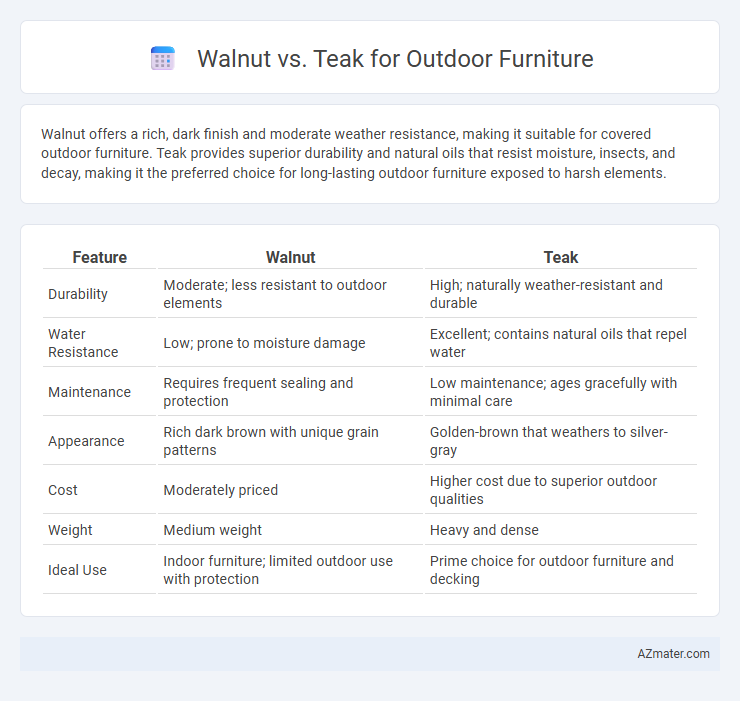Walnut offers a rich, dark finish and moderate weather resistance, making it suitable for covered outdoor furniture. Teak provides superior durability and natural oils that resist moisture, insects, and decay, making it the preferred choice for long-lasting outdoor furniture exposed to harsh elements.
Table of Comparison
| Feature | Walnut | Teak |
|---|---|---|
| Durability | Moderate; less resistant to outdoor elements | High; naturally weather-resistant and durable |
| Water Resistance | Low; prone to moisture damage | Excellent; contains natural oils that repel water |
| Maintenance | Requires frequent sealing and protection | Low maintenance; ages gracefully with minimal care |
| Appearance | Rich dark brown with unique grain patterns | Golden-brown that weathers to silver-gray |
| Cost | Moderately priced | Higher cost due to superior outdoor qualities |
| Weight | Medium weight | Heavy and dense |
| Ideal Use | Indoor furniture; limited outdoor use with protection | Prime choice for outdoor furniture and decking |
Introduction: Comparing Walnut and Teak for Outdoor Furniture
Walnut and teak are two popular hardwoods used in outdoor furniture, each offering distinct advantages in durability and aesthetics. Teak is renowned for its natural oils and dense grain, providing exceptional resistance to moisture and insects, making it ideal for long-term outdoor use. Walnut offers a rich, dark finish and fine texture, but requires regular maintenance to protect against weathering and ensure longevity in outdoor environments.
Wood Characteristics: Walnut vs Teak
Walnut features a rich, dark brown color with a fine, straight grain that offers elegant aesthetics and moderate natural durability for outdoor furniture. Teak boasts exceptional weather resistance due to its high oil content, dense grain, and natural tannins, making it highly resistant to moisture, decay, and insects. While walnut requires regular sealing to withstand outdoor conditions, teak's inherent oils allow it to age gracefully with minimal maintenance.
Durability and Weather Resistance
Walnut offers moderate durability with decent resistance to moisture but tends to weather and fade faster when exposed to prolonged outdoor conditions. Teak is renowned for its exceptional durability and natural oils that provide superior weather resistance, preventing rot, insects, and water damage. For outdoor furniture, teak is the preferred choice due to its ability to maintain structural integrity and appearance under harsh environmental exposure.
Maintenance Requirements
Walnut outdoor furniture demands regular maintenance, including annual oiling or sealing to prevent weather damage and preserve its rich color. Teak, renowned for its natural oils, requires less frequent upkeep, typically needing only periodic cleaning and occasional oiling to maintain its golden hue. Both woods benefit from protective coverings during harsh weather to extend their durability and aesthetic appeal.
Appearance and Color Changes Over Time
Walnut outdoor furniture features a rich, dark brown hue with fine grain patterns that deepen and develop a warm patina over time, enhancing its natural elegance. Teak showcases a golden-brown color that gradually weathers to a silvery-gray when exposed to outdoor elements, maintaining a classic and timeless appeal. The color evolution of walnut tends to retain warmth and depth, while teak's transformation highlights its durability and resistance to harsh weather conditions.
Sustainability and Environmental Impact
Walnut and teak differ significantly in sustainability and environmental impact for outdoor furniture, with teak often hailed for its natural resistance to decay, reducing the need for chemical treatments. Walnut, while less durable outdoors, originates from more widely managed forests and can be sourced from sustainably certified woodlands, offering a lower ecological footprint if harvested responsibly. Teak's long growth cycle and often questionable sourcing highlight the importance of choosing FSC-certified teak or reclaimed walnut for eco-conscious consumers prioritizing sustainable outdoor furniture.
Cost Comparison: Walnut vs Teak
Teak outdoor furniture typically has a higher upfront cost due to its natural oil content that resists weather and pests, ensuring longevity. Walnut furniture tends to be less expensive initially but may require more maintenance and protective treatments to withstand outdoor conditions. Long-term investment in teak often results in lower overall expenses due to its durability and reduced need for refinishing.
Best Uses and Applications Outdoors
Walnut offers moderate durability and a rich aesthetic ideal for covered outdoor areas such as patios and balconies, where exposure to moisture is limited. Teak excels in weather resistance and natural oils that prevent decay, making it the best choice for fully exposed outdoor furniture like garden benches and dining sets. Both woods require maintenance, but teak's superior density and oil content ensure enhanced longevity and resilience in harsh outdoor conditions.
Longevity and Lifespan of Each Wood
Teak wood is renowned for its exceptional durability and natural oils that resist rot, decay, and insect damage, making it ideal for outdoor furniture with a lifespan exceeding 50 years when properly maintained. Walnut, while prized for its rich color and grain, is less dense and more susceptible to moisture and environmental wear, resulting in a shorter outdoor lifespan typically around 10 to 15 years without extensive treatment. Choosing teak ensures long-term investment in outdoor furniture longevity, whereas walnut requires more frequent care and protection to withstand outdoor conditions.
Conclusion: Which is Better for Outdoor Furniture?
Teak outperforms walnut for outdoor furniture due to its exceptional resistance to moisture, insects, and decay, ensuring durability in various weather conditions. Walnut, while aesthetically rich with a deep brown hue, is better suited for indoor use because it lacks the natural oils that protect against outdoor elements. For long-lasting outdoor furniture investment, teak provides superior performance and lower maintenance requirements.

Infographic: Walnut vs Teak for Outdoor Furniture
 azmater.com
azmater.com